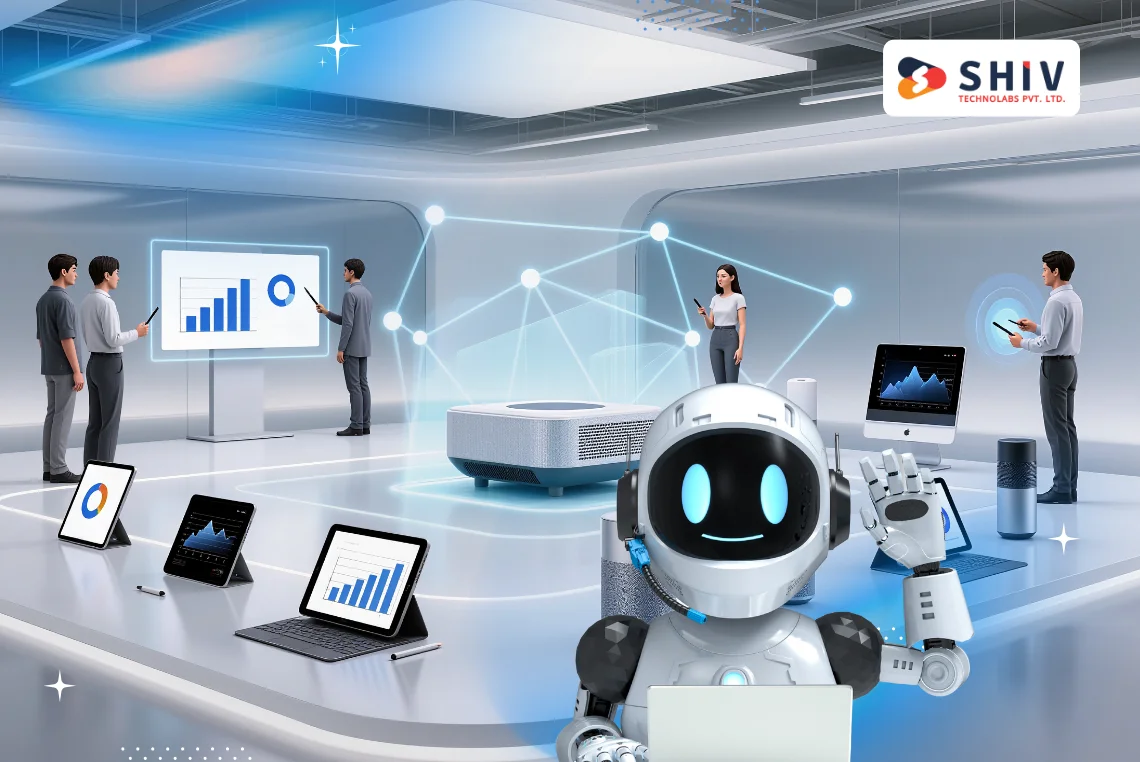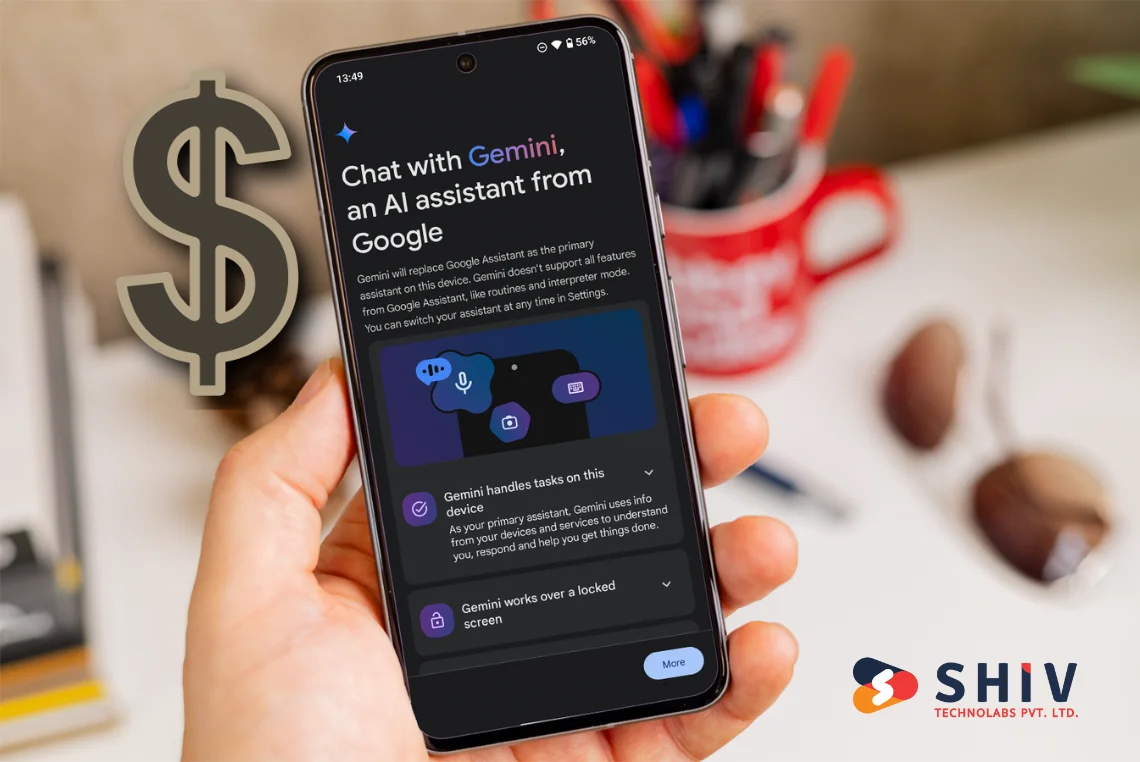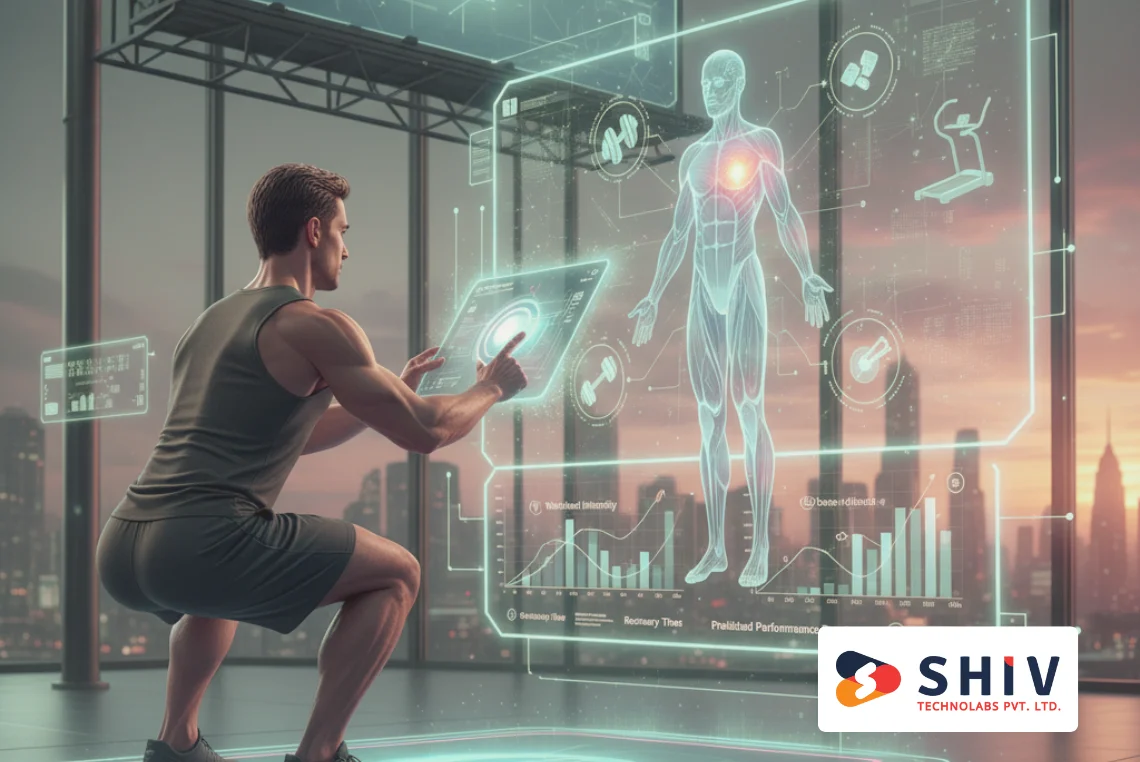Table of Contents
By 2025, companies will not be basing decisions on historical performance alone. Predictive AI systems are shifting the way enterprises predict market trends, optimize, and make decisions. By collaborating with a professional predictive AI creation firm, organizations can use complex volumes of data to generate practical insights, minimizing the amount of guesswork required and making decisions faster and more informed.
These AI-based tools combine machine learning, neural networks, and statistical models to identify patterns and make predictions, giving companies a strong edge in competitive markets.
Predictive AI is already playing a fundamental role in contemporary business strategy, particularly in inventory management and financial planning, enabling leaders to make assured decisions that drive a company toward growth and efficiency.
What Are Predictive AI Solutions and Why Do They Matter Today?
The predictive AI solutions refer to developed algorithms that examine the historical data and forecast future tendencies. Through predictive modeling, businesses can predict market dynamics, customer trends, and operational bottlenecks. Unlike conventional analytics, which involves reviewing past events, predictive AI focuses on proactive planning, helping leaders make informed decisions before things go wrong.
- Proactive Decision-Making: allows businesses to recognize opportunities and threats.
- Better Precision: This minimizes dependency on intuition and minimizes the number of mistakes by people.
- Operational Efficiency: Assists in resource distribution and optimization of work processes.
- Strategic Forecasting: It is also used in conjunction with business intelligence tools to support planning.
- Competitive Advantage: Leaders use insights to get ahead of the pack.
Traditional Analytics vs. Predictive AI Solutions
| Feature | Traditional Analytics | Predictive AI Solutions |
|---|---|---|
| Focus | Past data review | Future outcome forecasting |
| Decision Type | Reactive | Proactive |
| Tools | Excel, BI dashboards | Machine Learning, Neural Networks |
| Output | Reports | Predictions & Recommendations |
How Does Predictive AI Help in Business Decisions?
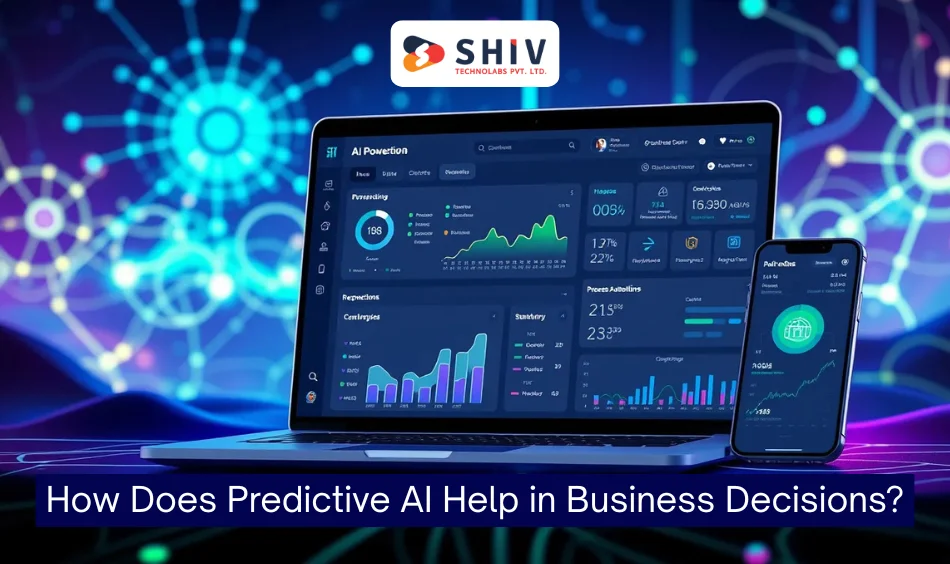
Predictive AI delivers actionable insights and makes strategic and operational decisions. By using AI in business decision-making processes, businesses will be able to react more quickly to market changes and perform better.
Data-Driven Forecasting and Planning
Predictive models enable companies to make accurate plans, anticipate and minimize uncertainty.
Key Areas Impacted:
- Inventory management
- Customer demand analysis
- Financial forecasting
- Workforce planning
Improved Accuracy and Reduced Human Bias
Machine learning models reduce subjective errors because they rely on data rather than intuition. Routine predictions should be automated so that managers can make quicker, timely decisions that will not fail. To illustrate, the sales forecasting provided by predictive AI can be used to avoid overstocking and exploit potential revenue opportunities.
What Are the Benefits of Predictive AI in Companies?
Companies implementing predictive analytics systems are entitled to some benefits directly associated with efficiency, profitability, and strategic planning.
Real-Time Decision Making
AI-driven dashboards provide real-time information to enable executives to make decisions without waiting for manual reports.
Increased Profitability and ROI
Predictive AI systems assist firms in cutting expenses and resource optimization. Key benefits include:
- Early risk detection
- Customer trend prediction
- Optimized operations
- Improved marketing performance.
Competitive Advantage Through Data Intelligence
Firms that use predictive insights to compete with others beat them by detecting opportunities and countering risks at a high rate, giving them a substantial advantage in volatile markets.
Operational Efficiency
Repetitive forecasting activities can be automated leaving employees to concentrate on strategic activities and minimizing the human error.
Better Customer Experience
Predictive models will be able to foresee customer needs, which will allow us to make personal recommendations and increase engagement.
Risk Management
The AI-based forecasting systems identify anomalies and possible threats, enabling the business to avoid losses and make proactive corrections.
Strategic Alignment
Predictive insights can be used to align the operational decision-making process with long-term business objectives, ensuring growth and sustainability.
How to Apply Predictive Analytics for Better Forecasting?
Predictive analytics has emerged as a pillar for companies that wish to understand market trends, streamline their activities, and make sound strategic choices. Using predictive analytics effectively ensures that companies can transform historical and real-time data into actionable insights.
Through predictive modelling in business, organisations can predict and reduce risks, as well as simplify business methods with greater confidence. Here, we are going to deconstruct the predictive analytics applied in the accurate forecasting process and identify the tools and technologies that enable this.
Data Collection
The initial measure will be to obtain data that will be of various sources. It may cover both structured data, such as sales records, financial reports, and CRM records, and unstructured data, including social media, customer feedback, and IoT sensor data. An AI development firm is predictive, meaning all necessary datasets are collected for analysis.
Data Cleaning and Preprocessing
Raw data can usually include inconsistencies, missing data, or information that is irrelevant. To remove errors, standardize data formats, and prepare data for use in predictive modeling, cleaning and pre-processing are necessary. This move has a direct effect on the accuracy and reliability of the AI-driven forecasts.
Model Selection
The selection of the appropriate algorithm is important. Thanks to a wide range of predictive models, the following are common:
- Regression Models: To learn about the correlation between variables and predict numerical results.
- Decision Trees: Best in the area of classification and structured decision-making.
- Neural Networks: They are practical in detecting complicated patterns within large datasets.
The company that produces AI predictors can assist in determining the optimal models depending on the type of data and the business goals.
Model Training
At this phase, past data are input into the predictive model. Machine learning algorithms are developed to learn patterns and correlations, which enable the system to make precise predictions of future situations. Training and validation have to be continuous to enhance the performance of the models over time.
Deployment & Monitoring
Predictive models are then incorporated in the existing business intelligence systems, ERP systems, or dashboards after training. Real-time monitoring ensures that predictions are up to date as new information is received and included in the model, keeping the model relevant and precise.
Tools and Technologies Used
Companies rely on specialized platforms to develop predictive models efficiently.
| Platform | Ideal Use Case | Scalability |
|---|---|---|
| TensorFlow | Deep learning & predictions | High |
| AWS SageMaker | Enterprise ML models | High |
| Azure ML | Easy deployment & integration | Medium |
With machine learning predictions and predictive modeling, businesses would develop robust forecasting systems that adapt to market trends.
Real-World Examples of Predictive AI in Business
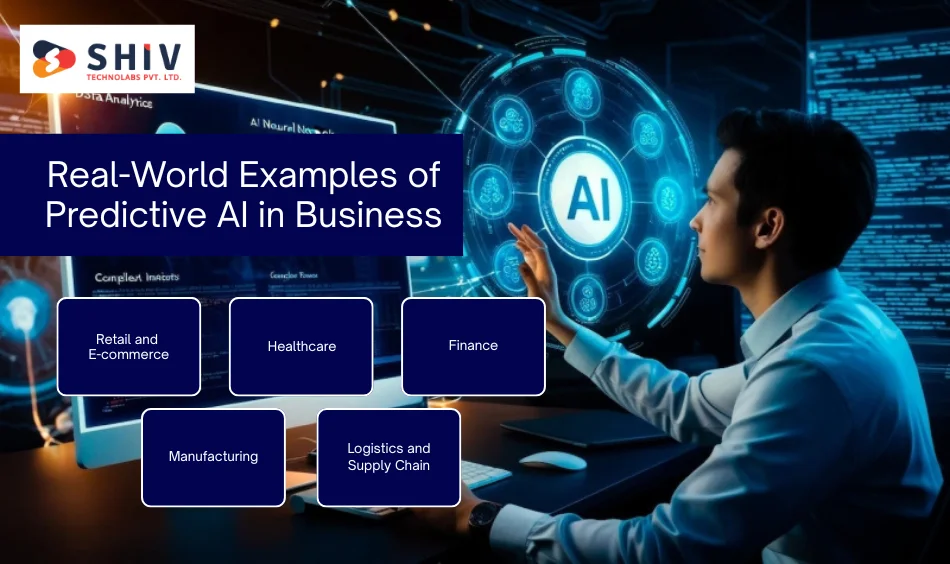
Predictive AI has already been successfully implemented in industries, increasing the efficiency of decision-making and operations.
Retail and E-commerce
AI predicts market needs and tailor-made product suggestions, boosting purchasers and consumer satisfaction.
Healthcare
Predictive models foresee readmissions and treatment outcomes among patients, maximizing care delivery and resource utilization.
Finance
Predictive data insight is used to improve credit scoring, fraud detection and portfolio risk analysis, minimizing financial risks.
Manufacturing
Predictive maintenance predicts equipment failure, saving time and money.
Logistics and Supply Chain
AI anticipates shipping delays and inventory shortages to enhance supply chain responsiveness and efficiency.
Why Businesses Invest in Predictive AI Development?
Predictive AI development is becoming an investment for companies due to its quantifiable core aspects of performance and scalability.
Observable contribution to expanded business
Predictive AI can make more revenue forecasts, reduce errors, and provide visibility into strategy, which can lead to informed investment decisions.
Long-Term Scalability and Integration
The AI solutions are well-integrated with ERP, CRM, and the cloud ecosystem to enable sustainable growth and long-term operational effectiveness.
Partnership with Experts
Collaborating with a professional Predictive AI development company like Shiv Technolabs, which focuses on predictive AI, provides access to technical skills, bespoke solutions, and time-tested approaches.
How to Choose the Right Partner for Predictive AI Projects
Choosing the appropriate partner is important in achieving the maximum potential of predictive AI solutions.
- Assess the experience and skills of the company.
- Check the technology stack and data regulations compliance.
- Evaluate scalability and integration support.
- Look at real-life examples and success stories of the past.
Collaborating with a reliable AI development firm would guarantee quality predictive analytics solutions that are business-focused.
Conclusion
Predictive AI is changing the way companies make decisions; it can quickly understand and provide accurate predictions as well as smart operational strategies. Shiv Technolabs is a leading predictive AI development firm, offering professional services specifically designed to help organizations transform data into actionable intelligence. Using AI-based predictive platforms, businesses will be able to mitigate risks, maximize resources, and gain a competitive edge.
If you are planning to make your business future-proof with predictive analytics, Shiv Technolabs has the expertise, technology, and support to transform insights into quantifiable growth. Get to know our services today to begin to make data-driven decisions that can drive your business.
Shiv Technolabs unlocks the power of predictive AI. Get in touch with us to deploy superior predictive AI applications that enhance productivity, high ROI, and strategic growth. Collaborate with specialists in the field of business intelligence and artificial intelligence decision-making.
FAQs
Q1. What is the overall aim of the business, Predictive AI?
Predictive AI helps companies look into the future by aiding in risk management, predicting future events, and making actionable decisions based on past information.
Q2. To what extent are Predictive AI models accurate?
The quality of data and algorithms is essential to accuracy. These elements can achieve 85–95% accuracy in enterprise quality systems, which improves over time with updates in machine learning.
Q3. What industries benefit the most from Predictive AI solutions?
The greatest beneficiaries are the retail, finance, healthcare, and manufacturing sectors as they can begin to notice ROI, optimization of the processes, and an increase in the efficiency of the operations.
Q4. What is the time of the Predictive AI project implementation?
The implementation can take different times based on the complexity of the data, the choice of algorithms, and the compatibility with the existing systems, typically ranging from 4 to 12 weeks.
Q5. What is the distinction between Predictive Analytics and AI solutions?
Predictive analytics uses statistical tools to forecast trends, while predictive AI introduces automation, self-learning, and real-time intelligence to continually improve the business.

